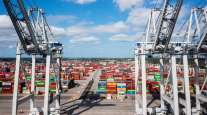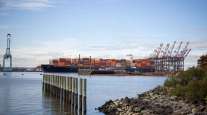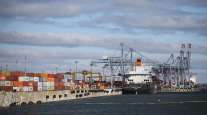Los Angeles, Long Beach Turn Times Drop as Cargo Volume Grows to February Record

Truck drivers took seven minutes less, on average, to enter and exit the two large Southern California ports in February compared with the same period a year ago.
It took drivers 81 minutes on average to travel across the entire San Pedro complex enveloping the ports of Los Angeles and Long Beach, Calif. — a drop of seven minutes. At the Port of Los Angeles it took 88 minutes while at the Port of Long Beach it took 73 minutes.
The ports of Los Angeles and Long Beach are the nation’s busiest and second-busiest, respectively.
The drop in turn times occurred as the two ports set volume records in the processing of 20-foot equivalent units, or TEUs.
“We continue to make progress in turn times,” said Weston LaBar, CEO of the Harbor Trucking Association. “Some terminals are still challenging. We need to fine-tune the consistency of turn times.”
Harbor Trucking Association works with Geostamp, using GPS and geofencing technology to measure the time between trucks entering the queue outside the gate to the time they exit the complex.
The quickest terminal was the Matson Terminal in Long Beach, with a turn time of 37 minutes, down four minutes from February 2017. The terminal with the longest turn time was APL (Eagle Marine Services) at Los Angeles with 115 minutes, up from 97 minutes a year ago.
LaBar cautions against comparing terminal turn times due to the variables of the work they do and the types of equipment they use.

LaBar
“Matson is a small, domestic terminal with its own containers, trailers and ships. Other terminals are international, multichassis, multicontainer, and bigger ships. It’s hard to compare,” LaBar said.
For its part, APL is a terminal that has been experiencing greater cargo volume, LaBar said. It also has a new owner and management team and is undergoing a construction project.
One challenge across the terminals is a drop in dual transactions conducted by trucks, where the driver drops off an export and picks up an import during one trip to a single location, LaBar said. Instead, more trucks are visiting a terminal and just dropping off or picking up a single load, then leaving the terminal to transport the load.
A dual transaction typically takes longer but is a more efficient way to move the most cargo, LaBar said. Single pickups and drop-offs lead to a wide range of turn times, and even lowers the average for some terminals, but the practice is an inefficient use of trucks and drivers, LaBar said.
The ports in February didn’t make progress on reducing the percentage of moves that take two hours or longer. Twenty percent of trucks were stuck at the terminals for that long in February, the 10th month in a row that 20% or more of trucks took at least two hours to get their business done.
LaBar said that should be improved with the planned implementation of a new pier pass system that imposes a universal flat fee for all trucks entering the piers. That will raise fees for nighttime entry but it should reduce congestion and be fair to everyone, LaBar said.
The Port of Los Angeles processed 725,059 TEUs last month, making it the busiest February in the port’s 111-year history. Total volume was up 16% for the month compared with February 2017. The Port of Long Beach processed 661,790 TEUs, a nearly 33% increase from February a year ago.




